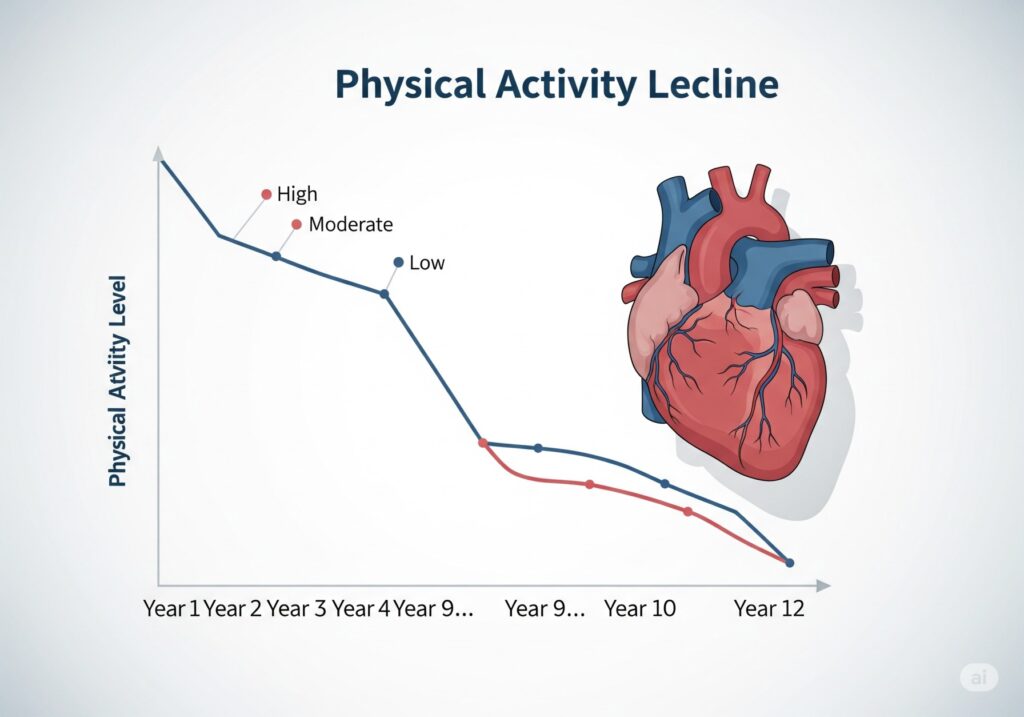
Decline in physical activity as an early heart attack warning
A subtle decline in physical activity may signal a heart attack up to 12 years ahead. Learn to spot it early and protect your heart health.
Introduction
Your heart is smart. It often warns you before a disaster strikes. Yet, most of us miss the signals. A recent study reveals that a decline in physical activity can start up to 12 years before a heart attack. That’s a full decade to take action! In this blog, we’ll explain the warning, why people overlook it, and what you can do now to protect your heart.
What the Study Found About Decline in Physical Activity

Researchers tracked people over many years. They noticed a slow drop in moderate-to-vigorous physical activity (MVPA). This decline began up to 12 years before a heart attack. Most people didn’t realize it. It crept in gradually. No dramatic symptoms. Just fewer and shorter bursts of exercise. Soon, your heart is struggling without you noticing. This is backed by a Times of India report summarizing the study The Times of India.
Why Many Miss the Decline in Physical Activity
It’s easy to ignore. We’re busy. We’re tired. We don’t track how many steps we take. We compare to friends, not ourselves. We think small changes aren’t a big deal. Yet, the research suggests that even moderate declines matter. They reflect a growing strain on the heart. Over time, the heart may be silently weakening. Without alarms, most of us stay unaware, The Times of India.
Why Physical Activity Matters for Heart Health
Physical activity strengthens the heart muscle. It improves blood flow. It helps manage weight, blood pressure, and cholesterol. It cuts stress and reduces inflammation. When activity declines, these benefits slip away. The heart becomes vulnerable.
The American Heart Association emphasizes physical activity as a key way to prevent heart disease www.heart.org. Even small, consistent efforts help.
Early Warning vs. Other Indicators
Often, we wait for high cholesterol or blood pressure. But these may show up much later. The study noted that activity decline comes first, years before those markers rise, The Times of India. That’s why watching your activity levels might be a smarter early warning.
How to Track and Reverse the Decline in Physical Activity

1. Use Tracking Tools
Wear a pedometer or a fitness tracker. Even a smartphone can work. Track daily steps, active minutes, and intensity. Notice downward trends.
2. Set Simple Goals
Aim for 150 minutes of moderate activity per week. Or 75 minutes of vigorous activity Wikipedia. Break it into short walks or mini workouts.
3. Stay Accountable
Buddy up. Join a group. Or share progress on social media. A little support makes a big difference.
4. Add Variety
Walk, swim, dance, cycle, or go up the stairs. Mix it up to keep it fun. That helps sustain activity.
5. Get Professional Support
See a doctor or a cardiologist. Ask for a heart risk assessment. A risk calculator can estimate your 10-year risk and help guide you to www.heart.org. Discuss ways to safely build or resume activity.
Technology Can Help You Spot the Pattern
Apps can now flag when your activity dips below your average. Some wearables alert you if your weekly average falls—use that warning to act fast.
Prevention Starts Now — Don’t Wait
Spotting a drop early gives you time. You can strengthen your heart before symptoms appear. You can regain stamina. You can slow or reverse the damage.
Here’s a simple plan:
- Track: Use a fitness tracker or app.
- Move more: Walk daily or do light workouts.
- Mix it up: Try new activities.
- Support: Involve friends or fitness groups.
- Check in: Visit your doctor for tests and advice.
What If You’ve Already Had a Drop?
Don’t panic. It’s never too late to act. Start gently. Even short walks help. Build up gradually. Talk to a healthcare provider. They may recommend cardiac rehab or a personalized plan.
Beyond Activity — Other Key Prevention Steps
Physical activity is powerful. But heart health is about more than movement. Combine healthy habits:
- Eat better: Choose fruits, vegetables, whole grains, lean protein, and healthy fats like olive oil. Limit sugar, salt, and trans fats. Wikipedia.
- Don’t smoke: Quit or avoid tobacco. It’s a major risk factor.
- Manage stress: Try mindfulness, breathing, or breaks. Chronic stress harms the heart.
- Control conditions: Stay on top of blood pressure, cholesterol, and blood sugar.
- See your doctor: Especially if you’re over 40 or have risk factors www.heart.org.
Combine Movement with Smart Lifestyle Choices
Together, these healthy actions multiply your protection. You’ll boost heart health, mood, energy, and longevity.
Conclusion: Listen to Your Heart, Act Early
It’s not fear. It’s power. Knowing that a decline in physical activity can warn you 12 years in advance gives you a head start. It’s your chance to steer away from danger.
Track your movement. Notice the drops. Move more. Check in with your doctor. Make smart choices.
Your heart gives you time. Use it wisely.
References & Further Reading
- “Your heart sends warnings 12 years before a heart attack…”, The Times of India.
- “Heart health issues can start a decade before cholesterol…”, The Times of India.
- American Heart Association: Risk & Prevention, Heart.org www.heart.org.
- Myocardial infarction prevention, Wikipedia.
Medical Disclaimer
This article is for informational purposes only and is not a substitute for professional medical advice, diagnosis, or treatment. Always seek the guidance of a qualified healthcare provider with any questions you may have regarding your health or a medical condition. Never disregard or delay professional medical advice because of something you have read here.
Call to Action
Your heart is giving you time—don’t wait to act. Start tracking your daily activity today, schedule a check-up with your doctor, and take simple steps to protect your heart health. Share this article with friends and family so they can learn the early warning signs too. Together, we can prevent heart disease before it strikes.





